Disclosure: Meeple Mountain received a free copy of this product in exchange for an honest, unbiased review. This review is not intended to be an endorsement.
“Have you been to Cape May?” Tim asked.
I have, I thought. Tim Virnig, marketing guru for Thunderworks Games, was chatting with me at the Thunderworks booth at PAX Unplugged in December. Even asking if I had been to Cape May, New Jersey took me back to two recent beach trips with my family over the last 5 years. Lovely town. Nice people. A short drive from Atlantic City. Decent food, great beach, good times.
Cape May is the setting for the board game Cape May by Thunderworks Games and just looking at the physical production got me excited to take a review copy home to get it to the table. Across half a dozen plays, I’ve decided that Cape May is that comfy sweater you pull out in the wintertime when you don’t want to use your brain and want to grab something easy to throw on while working at home. it’s cozy, it fits, and it looks great when you are sitting on yet another Zoom call with colleagues.
Cape May is that sweater because for gamers of a certain age, it’s nice sometimes to pull a game off the shelf that doesn’t do anything particularly unique but does everything well. The theme and the setting elevate the material for me; paired with a very generous selection of actions and heavy plastic pieces that could have easily been swapped out for cheaper materials, Cape May is a pleasant addition to my collection.
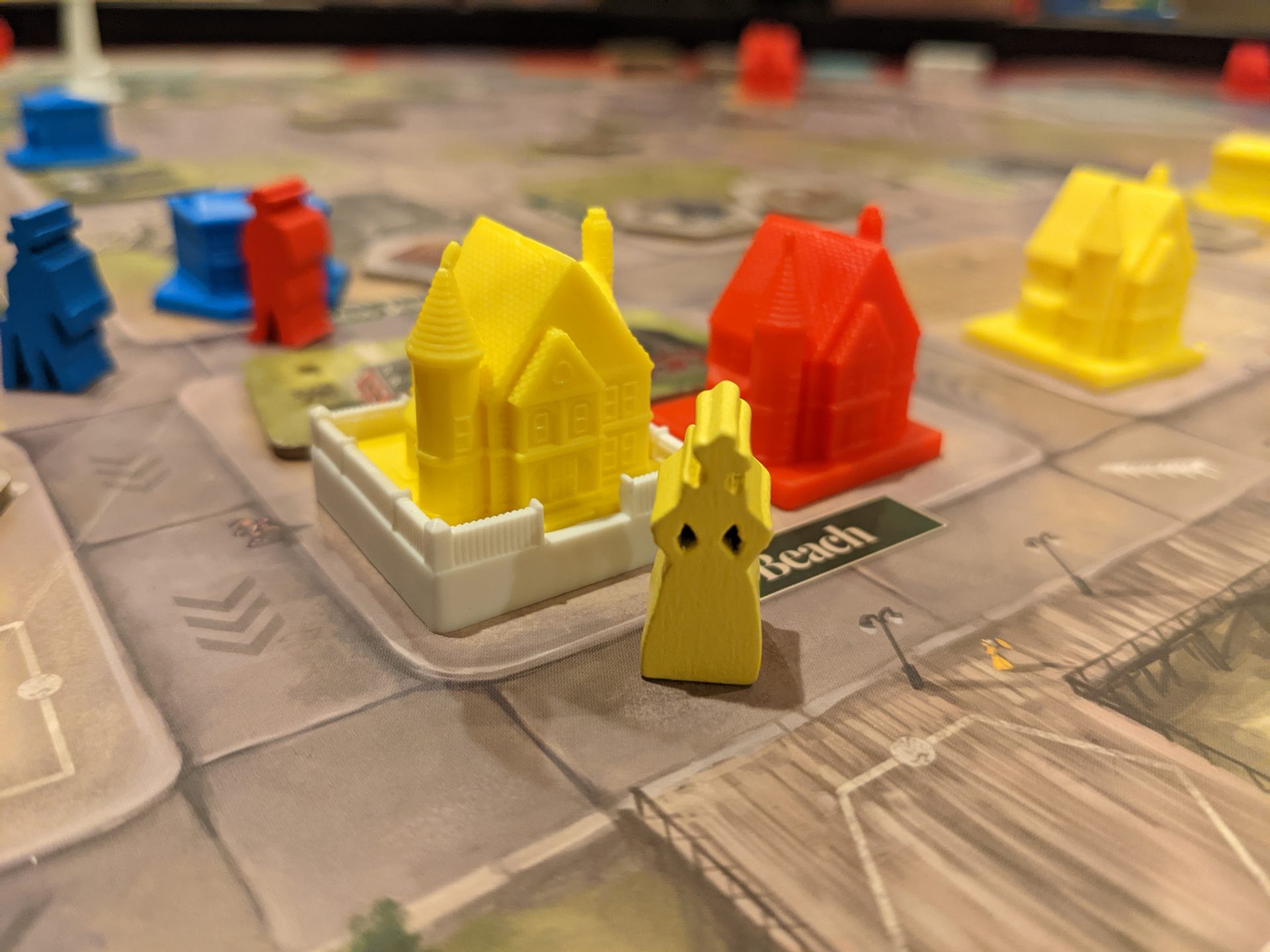
Let’s Hit the Boardwalk
The older I get, the more I love one thing in gaming more than maybe any other: being able to teach a new game by using only the list of player actions and end-game scoring conditions displayed on a player board. Cape May is such a game!
Over the course of a year, you’ll take on the role of an entrepreneur in Cape May, NJ to build up the town from meager beginnings into a bustling seaside tourist destination. 36 total actions—3 per month—is all you’ll get to build residential and commercial buildings across 4 zones on the board, trying to win area majorities in each zone while scoring extra points for fancy homes, achieving goals on secret, personal bonus cards, and gathering a random collection of bird tokens by the end of the game.
Turns are smooth in Cape May. After an event card is revealed, changing a rule or two slightly for that month, each player takes a turn to complete 3 actions. Moving, erecting residential and commercial buildings, upgrading buildings, gaining $3 from the bank, and picking up the cards you use to navigate the board comprise the majority of your actions, and you can duplicate any action within the limit.
There are two other actions you get during a turn, tied to the best game-breaking feature in Cape May: Activity cards. You can draw 2 Activity cards, keeping one, or you can play Activity cards. You’ll start the game with 2 of these cards, but then receive 2 more for free after the 3rd, 6th, and 9th round to keep the drip of options open all game long.
What makes Activity cards so special? They are all great, they all provide the option of doing one of two separate actions, and they often give players a cash discount on a normal build or move action. Some cards even increase your efficiency by allowing you to take 2 build/upgrade actions as a single action. Other cards let you move to the opposite end of the board. And certain cards let you build anywhere on the board, as opposed to the game’s normal requirement to build in a space adjacent to where your character’s meeple is located.
Yeah.

In all of my plays, the Activity cards seem to be where it’s at. And this also means that between taking the gain $3 action or drawing more Activity cards, you’re never stuck in Cape May. The word one of my review crew members used to describe this feeling is “generous” because it just feels like the designers went out of their way to build a game that never leaves a player in the dirt, fishing around for something to do if they are really in trouble.
It’s easy to boost your income by building commercial buildings. It’s easy to find game-breaking Activity cards. It’s easy to get once-per-round player powers if you can upgrade your shops into full-blown businesses. It’s easy to move around the board, with a hand of cards that allow you to move exactly 1-7 spaces, and other Activity cards that let you move 9, 10 or more spaces depending on where you need to go. If you don’t find fortune in placing buildings on the map, you could just move around and acquire Bird Tokens, which are pulled randomly out of a draw bag and reward set collection for different types of birds gathered while walking the city.
Because it’s easy for every player to make their fortune in Cape May, everyone is on equal footing. And that made the experience fun for my gaming group, especially in a world where we are used to slugging it out in a tense economic affair or tight “Ameritrash” skirmish game. Cape May is a lot like a vacation on the Jersey shore: there might be a hiccup or two here and there, but, for the most part, it’s not a combative experience.
Once the final round is played, players tally up scores from their starting Bonus cards, Bird Tokens, commercial upgrade cards, area majorities (whoever has the most buildings in each of the 4 zones on the map gets points), upgraded residential buildings (Victorians and landmarks), and any leftover cash.
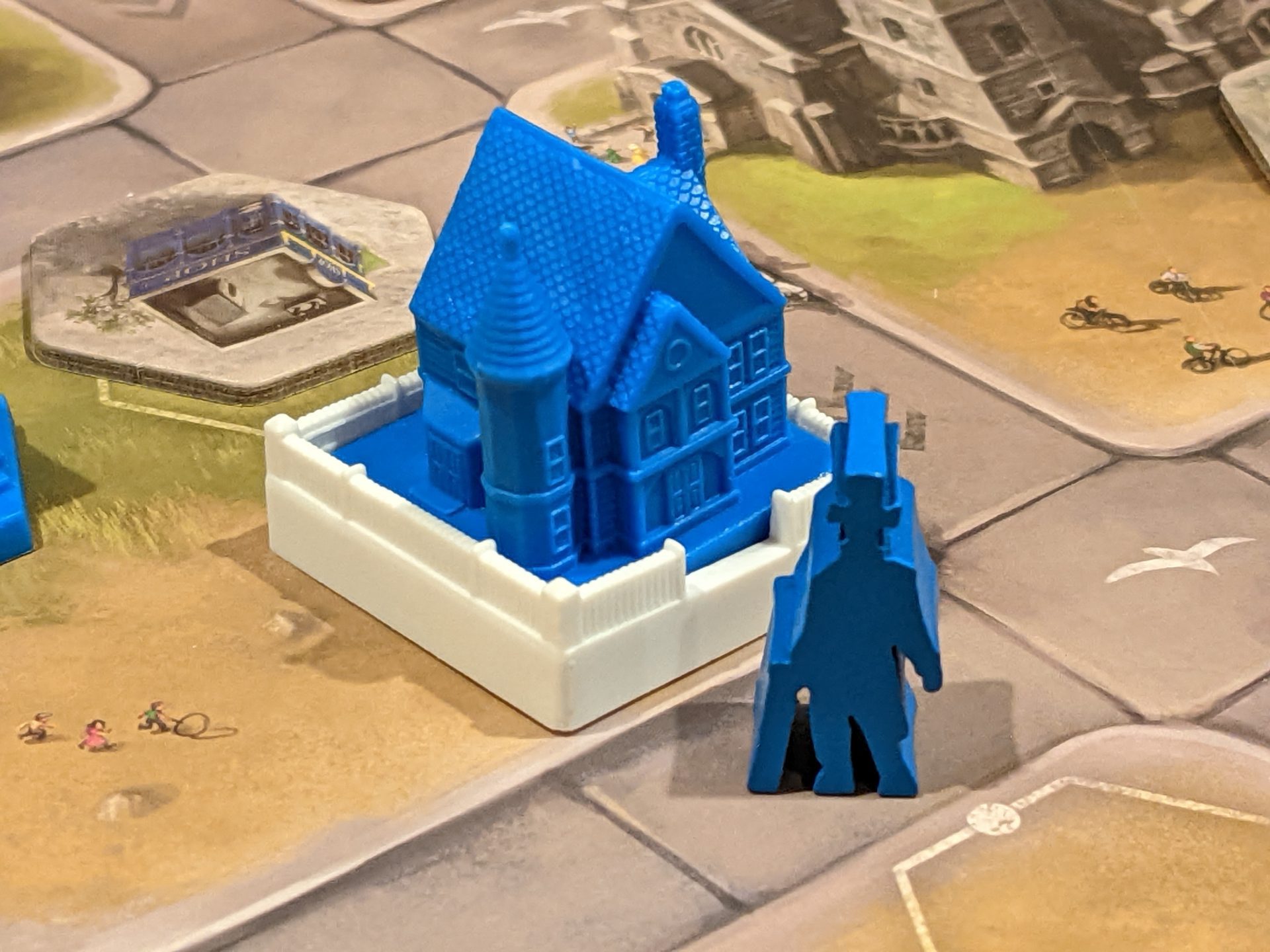
Chunky
When Keith Matejka (the owner of Thunderworks as well as the designer of Roll Player and Roll Player Adventures) handed me the review copy of Cape May, I had to admit: I was shocked at how heavy it was. Opening the box upon my return home revealed why: Cape May has some of the most luxurious and chunky plastic pieces in a game I will play this year. The Victorian and Business pieces are fantastic and they add an incredible physical look to the game when they are added to the board. The detail on the shingles on the Victorians are completely unnecessary, which of course means they are even more fabulous when you are juggling them in your hands between turns.
The best components in Cape May? Those landmark bases!
Residential buildings advance through 3 stages. When you place a cardboard token on the board in your color, it’s a cottage. Then you upgrade that into a Victorian. But for $10, you can upgrade that Victorian into a landmark, which scores additional points at the end of the game. More importantly, the landmark base is a white-picket fence. You place your Victorian inside, so your piece looks like it suddenly has a white-picket fence. Magic!
I always replace the cardboard money tokens in games with my Iron Clays poker chips, but the included money chits in Cape May are actually pretty nice. Ditto for the variance in the meeples for each player; I like the mix of women and men who are featured here, with the women wearing dresses that are cut in a way that help colorblind players who struggle to differentiate the colors of the wooden pieces.
The bird artwork is lovely too. I have some issues with the color scheme of the zones which we will get to, but generally Cape May is a good-looking production with enough heft to feel great about buying a copy of the game.

Stellar Solo
To prepare to teach Cape May, I played a couple rounds of the solo variant to get a handle on how the multiplayer game would play. So, I played it once, then twice, then a total of 4 times. I really like it. I might even love it. An included solo deck and a rule that aligns very closely with the Activity cards in the multiplayer game makes turns quick and smooth in the solo variant:
At any time, someone is going to drop a random building somewhere else on the map.
The solo deck has a picture of the entire board on each card, with a symbol tied to the season so that you know exactly which spot to build whatever the AI builds on each turn. Sometimes the AI will take a second action. Sometimes it will get a bird token, moving itself up that track on its AI board. There are 4 included difficulty levels for the AI so it’s easy to find ways to continuously challenge yourself. I have found that Easy and Normal are almost too easy to beat if you commit to the game’s “meta”, although we will also cover later why this might be a bad thing. The Hard and Challenging difficulties are a nice challenge.
I wouldn’t buy Cape May only for the solo, but it is perfect for learning the game on your own before teaching it to others. Kudos to solo designer Scott Bogen for building a very capable module.
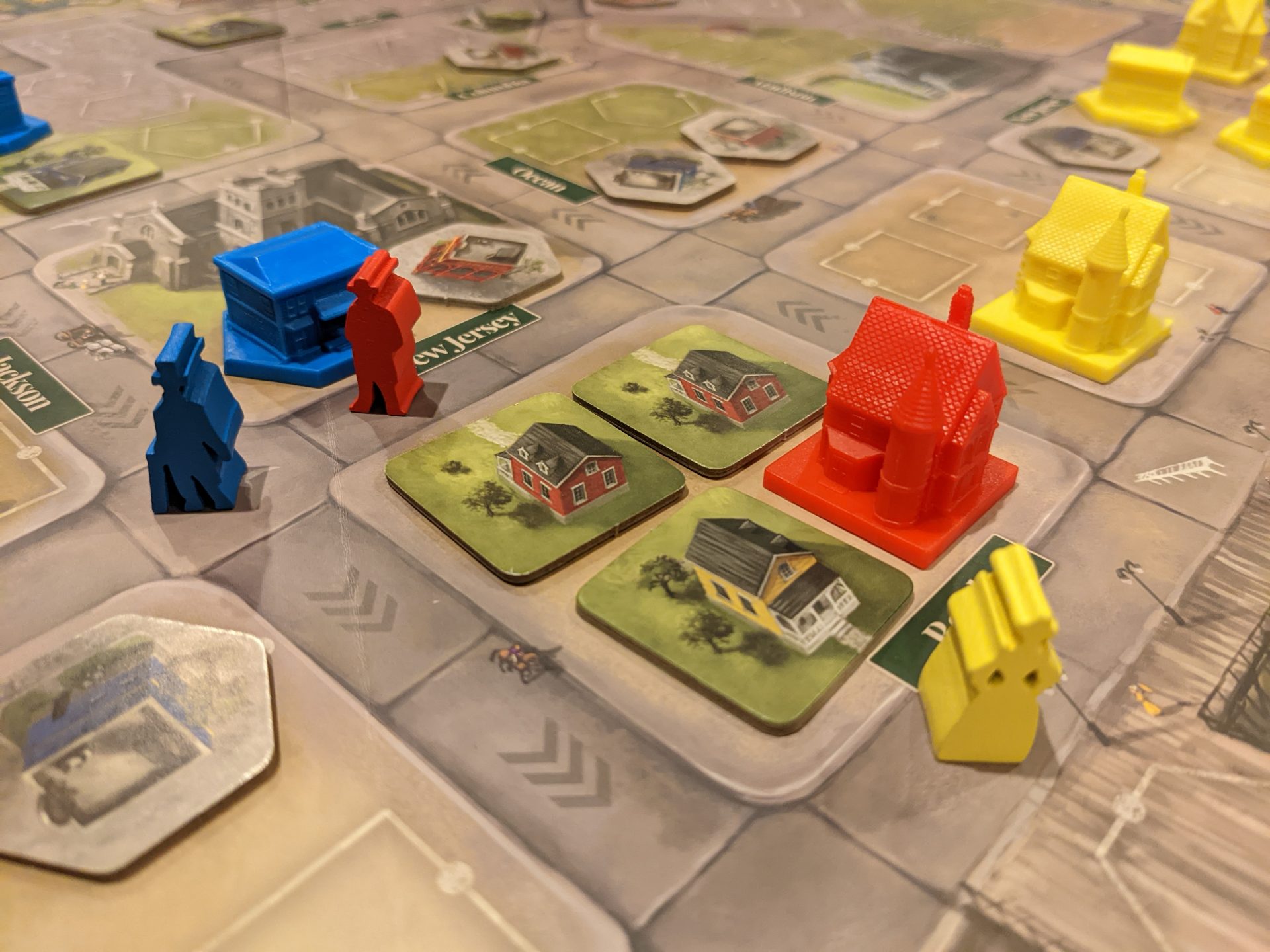
Some Critical Commentary
Oh, that board!
The most frustrating physical aspect of Cape May is easily the game board’s zone and color coding system. There are four zones on the board: gravel, grass, dirt and sand. Sadly, the zones are very hard to parse out while playing—in every single play, players struggled to figure out which spaces were dirt versus sand. Worse, the zones are not aligned by streets and blocks. So, every block is split into 2 zones, as opposed to just having the board lay out as a 4×4 grid where the top row of city blocks represent gravel, the second row of city blocks are grass, etc.
This is vital because of how the game scores area majorities. You will inevitably think you have the most buildings in, say, the grass zone, only to realize that one of your buildings is actually in the dirt zone, and you will curse the board. Or you will mess up which player has the most Victorians in the sand zone only to realize you double-counted a building that was in the sand zone.
It’s not that the board is visually a mess; in fact, the artwork on the board is totally fine and very functional during gameplay. But the color schemes for the zones and the decision to break up each zone across city blocks are collectively a miss.
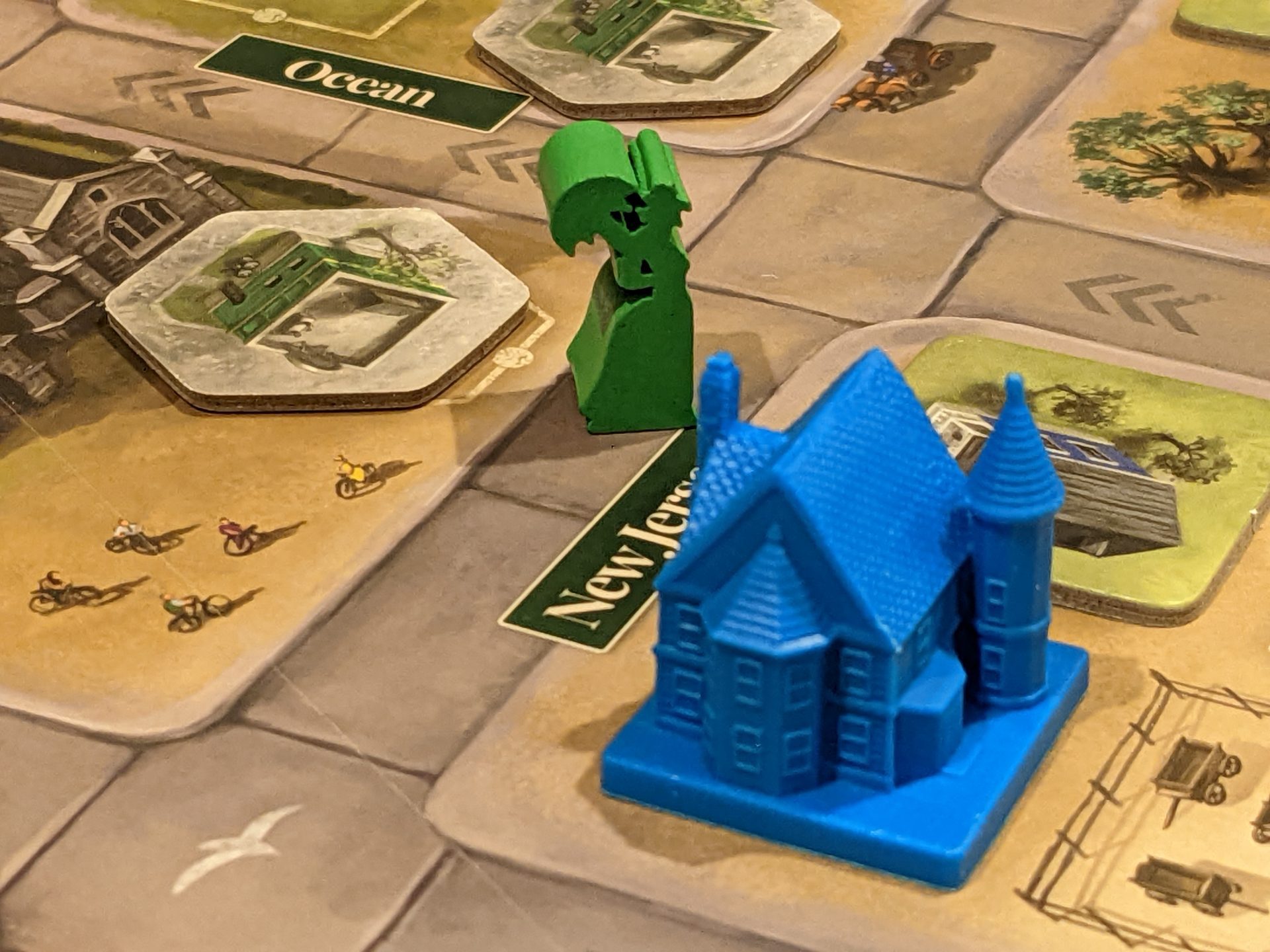
Beyond the board, there’s no getting around the fact that the event cards are incredibly swingy. In all of my multiplayer games of Cape May, we had multiple rounds where, basically, nothing happened on the event card because its event didn’t happen to affect any players.
But in many other situations, a single player benefited from that round’s random event, often with a handsome payday. Once, a player benefited from a random event that paid $2 per Victorian in the sand zone; that player earned $10 when she was completely out of cash, which allowed for her to take a couple of actions in that round that she couldn’t otherwise have completed.
In another case, a zone of the board was randomly on fire, meaning building costs were higher in that round. This meant that the one person trying to build in the on fire section of the map had to spend more money than expected, resulting in his need to take the collect $3 action to complete the round.
I generally don’t like event cards in games, but I see the appeal as a way to shake up how each round in a game is played. None of the events in Cape May will break your game so I can’t honestly say that I’ve won or lost any of my plays because of a single event card. But some players will disagree, and I can see some players removing the event deck entirely if they want to remove the randomness associated with the event deck.
The meta for Cape May feels pretty clear: build shops and businesses early and often to boost income, while spreading cottages across the gravel and grass zones and building Victorians and landmarks in the sand and dirt zones. In this way, you’ll have a chance at winning the area majority in the zones that score the most points while focusing on high-point residential buildings in the more attractive districts.
Scoring at least one, if not both, of your Bonus end-game goals to their max of 8-10 points each will prove critical as well. If you don’t build shops during spring (the first 3 rounds of the game), your income will be too low to take significant building actions during the summer. With limited building spaces it can be hard to recover even with some of the best activity cards in the deck.
This doesn’t make the game boring, but it does make me wonder if replayability will be a factor later.
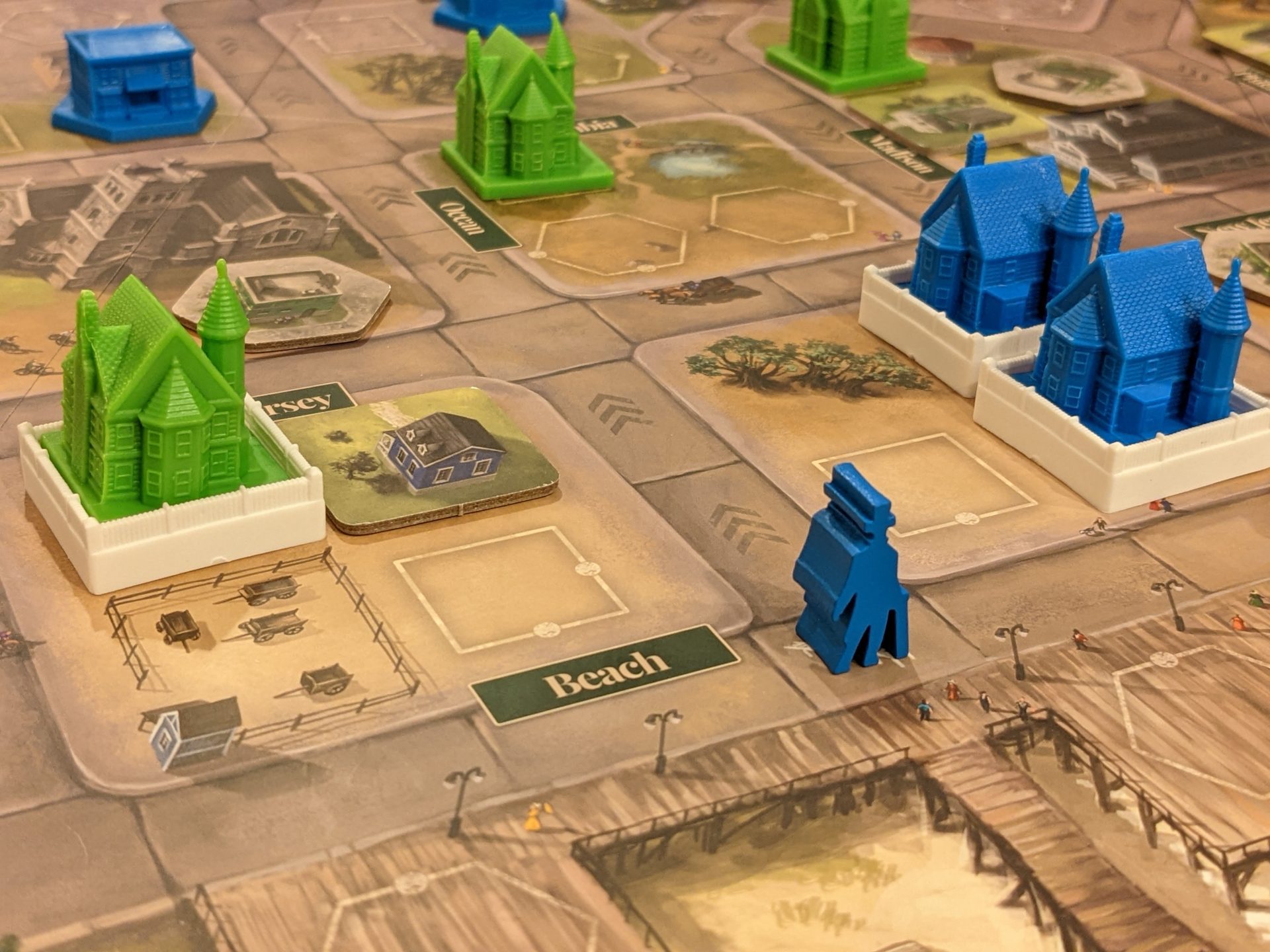
Expansions Will Keep Us Warm
Cape May is an accessible, generous economic engine builder with a healthy dose of chance built into the proceedings. The chunky building pieces, simple teach, solid solo play and smooth turns have made it easy to get Cape May to the table. The finished game state looks bright and cheerful—taking beautiful pictures of a game has rarely been this easy—and thanks to the end-game scoring goal cards, you’ll always have a mission at the start that must be filled if you are going to have a chance to win. Providing direction to new players makes the game even more inviting.
But Cape May has its flaws, especially when considering its long-term viability. The included mini-expansion doesn’t have nearly enough game-breaking options for the one-time player powers. Savvy gamers will take one look at the board and realize that getting shops and cottages into the gravel zone while using Activity Cards to build anywhere on the map is key, especially if those Activity Cards allow for building shops in the dirt or sand zones where the income boost is significant.
The game makes it almost too easy to make money, but I was okay with that. Dozens, hundreds even, of games seem to be harsh when it comes to collecting enough money to take meaningful actions. “Money is tight in this game”, said no one, ever, when playing a game of Cape May. Heck, this game is so forgiving that when parts of the map are literally on fire, none of the existing buildings burn to the ground!
I can get almost any type of gamer to play Cape May at least once, and this is a delightful 2-player race when I get to play it with my wife. You can knock out a game in under an hour with 2 or even 3 experienced players, and in a world when many games overstay their welcome Cape May is a breezy alternative.
Bigger decks of upgrade cards? Yes, please. More variability in starting locations? That would be interesting too. Spaces that allow for players to draw more bonus cards? This would allow for additional scoring opportunities during the game, to create more tactical opportunities to boost victory points. Even making the seasons really matter—how about increasing income from beachfront commercial buildings during the summer?—would be cool ways to incent players who build out that portion of the board. Adding a 5th player or a city government AI to slowly close off building spaces to create scarcity might make the race even tighter.
Cape May has room for more, but what’s here is a great start and a solid production. I continue to enjoy Thunderworks Games products and Cape May is another winner!


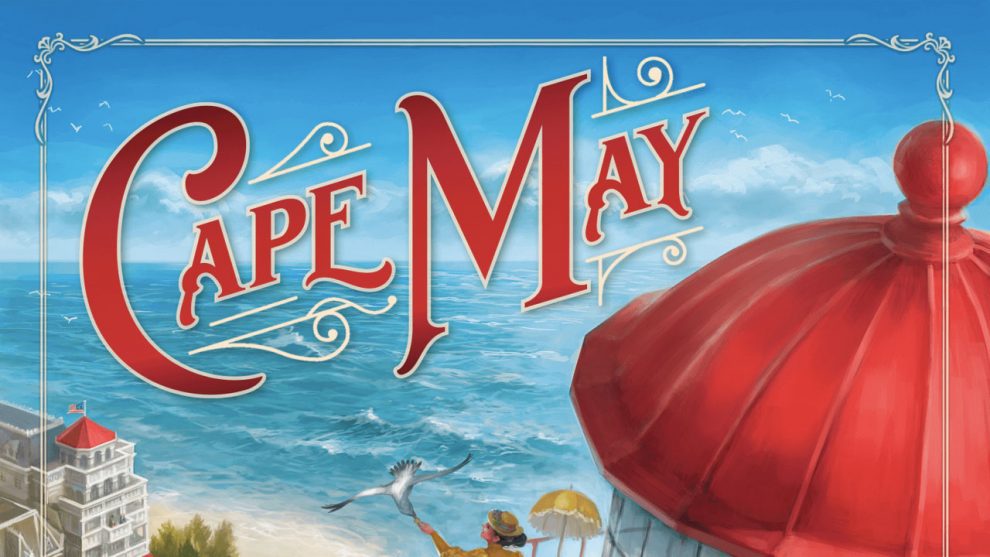









Question, not a comment…
Are the streets named and are they accurate?
Thanks for the question Debby! The streets are named, but I can’t comment on the accuracy; I don’t know the real-life streets of Cape May well enough. Hope this helps!